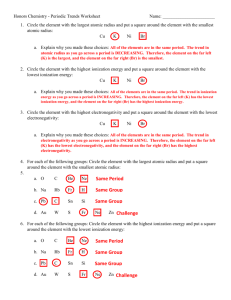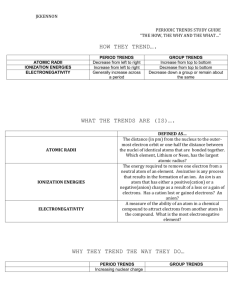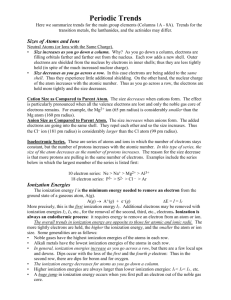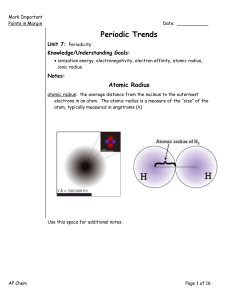2014 Review- use the powerpoint and you notes Define:1
advertisement
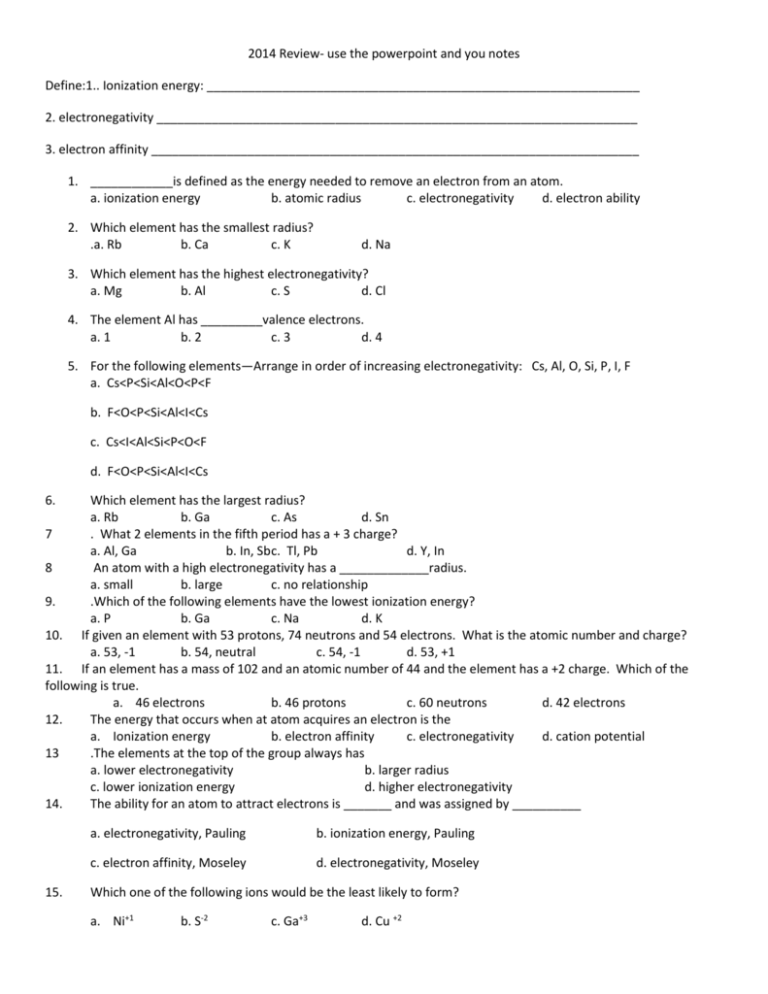
2014 Review- use the powerpoint and you notes Define:1.. Ionization energy: _______________________________________________________________ 2. electronegativity ______________________________________________________________________ 3. electron affinity _______________________________________________________________________ 1. ____________is defined as the energy needed to remove an electron from an atom. a. ionization energy b. atomic radius c. electronegativity d. electron ability 2. Which element has the smallest radius? .a. Rb b. Ca c. K d. Na 3. Which element has the highest electronegativity? a. Mg b. Al c. S d. Cl 4. The element Al has _________valence electrons. a. 1 b. 2 c. 3 d. 4 5. For the following elements—Arrange in order of increasing electronegativity: Cs, Al, O, Si, P, I, F a. Cs<P<Si<Al<O<P<F b. F<O<P<Si<Al<I<Cs c. Cs<I<Al<Si<P<O<F d. F<O<P<Si<Al<I<Cs 6. Which element has the largest radius? a. Rb b. Ga c. As d. Sn 7 . What 2 elements in the fifth period has a + 3 charge? a. Al, Ga b. In, Sb c. Tl, Pb d. Y, In 8 An atom with a high electronegativity has a _____________radius. a. small b. large c. no relationship 9. .Which of the following elements have the lowest ionization energy? a. P b. Ga c. Na d. K 10. If given an element with 53 protons, 74 neutrons and 54 electrons. What is the atomic number and charge? a. 53, -1 b. 54, neutral c. 54, -1 d. 53, +1 11. If an element has a mass of 102 and an atomic number of 44 and the element has a +2 charge. Which of the following is true. a. 46 electrons b. 46 protons c. 60 neutrons d. 42 electrons 12. The energy that occurs when at atom acquires an electron is the a. Ionization energy b. electron affinity c. electronegativity d. cation potential 13 .The elements at the top of the group always has a. lower electronegativity b. larger radius c. lower ionization energy d. higher electronegativity 14. The ability for an atom to attract electrons is _______ and was assigned by __________ 15. a. electronegativity, Pauling b. ionization energy, Pauling c. electron affinity, Moseley d. electronegativity, Moseley Which one of the following ions would be the least likely to form? a. Ni+1 b. S-2 c. Ga+3 d. Cu +2 16.. Which is smaller: K or K+1 and why a. K, because it gained an electron c. K+1, because it gained an electron b. K , because it has more attraction to the electrons d. K+1, because it has more attraction to the electrons . 17.For the following elements rank the radius from large radius to small a. Ba>Tl>Na>Al>Si>S>O c. Tl>Ba>Na>Si>S>Al>O Ba , O ,Al, S , Na , Tl , Si b. Tl>Ba>S>Si>Al>Na>O d. Ba>Tl>Si>S>Al>Na>O 18. Which element has the highest Ionization energy a. Br b. Sb c. Rb d. Ra 19. The first four ionization energies are 140 kJ, 200 kJ, 500 kJ, and 1214 kJ. Based on these ionization energies, which element is the best choice to be represented? a. Ca b. Rb c. C d. Ga 20. The size of the atom generally increases as you move down the group because: a. more protons in the nucleus b. more attraction to the electrons c. more electrons and more energy levels creating more attraction from the protons d. more electrons and more energy levels creating less attraction from the protons 21. Which element has the lowest ionization energy? a. Be b. K c. Cs d. Sr e. Ba 22 Which one of the following ions is incorrect? a. F-1 b. P-2 c. O-2 d. N-3 23. When the second electron is removed from an atom, the ionization energy ______ a. increases, due to an increased attraction to the remaining electrons b. increases, due to the addition of a proton c. decreases, because it doesn’t care about the other electrons d. decreases, due to an increased attraction to the remaining electrons 24. The most reactive NONMETAL is: a. He b. F c. At d. Rn 25. The new element has a luster and is conductive. The new element #120 can be described as a a. metal and forms a cation b. metal and forms an anion d. nonmetal and forms an anion c. nonmetal and forms a cation e. metalloid and charge may vary Show all work and use sig figs for these problems: 1. 2. 3. 4. 5. 6. How many atoms are contained in 5.98 moles of Gallium? If you measured 89.9 grams of Aluminum, how many moles is this equal to? 8.99 x 1024 atoms were needed for the comparison, how many grams of Nickel was required? How many grams are contained in 1.66 moles of Calcium? 7.34 x 1025 atoms are equal to how many moles? 169 grams of Sodium is equal to how many atoms?



